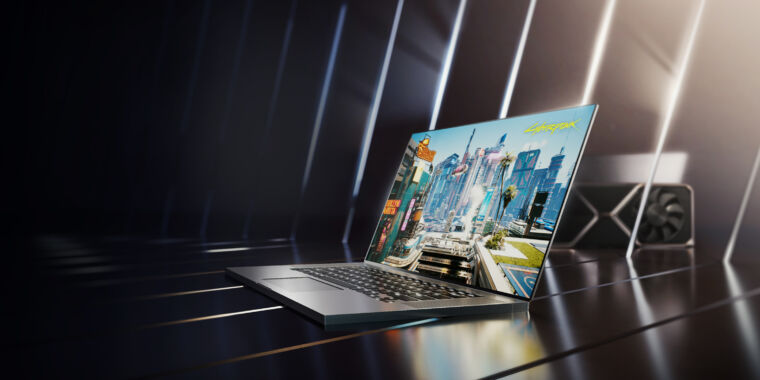Nvidia’s next laptop GPU generation powers a leap to 1440p displays
[ad_1]
-
There’s apparently an Nvidia GeForce RTX 3000-series GPU inside of this laptop, and it’s apparently launching on or after January 26.
-
A range of laptop models with RTX 3000-series GPUs built in. Nvidia wasn’t ready to release a complete list of which models will launch on January 26.
-
This is all we have thus far in terms of performance-gain estimations, and… yeah, it’s a bit vague, Nvidia.
If you’ve been wondering when gaming laptops would begin a more serious push to 1440p panels, this week’s CES reveals from Nvidia are aimed directly at you. Behold: a generational jump in the company’s laptop-minded GPUs, this time with Ampere architecture and RTX 3000-series branding.
Three GPU models have been announced in all, and they’re named after the GeForce RTX 3080, 3070, and 3060. They are slated to roll out in “70+” laptop models starting January 26. Nvidia has listed “top OEMs” like Acer, Alienware, ASUS, Gigabyte, HP, Lenovo, MSI, and Razer with upcoming RTX 3000-series laptops, along with “local OEMs and system builders.”
Naming convention double-check
Nvidia’s sales pitch positions the RTX 3060 laptop variant as “faster than laptops featuring the RTX 2080 Super,” though this model may land more specifically in 1080p systems. The two higher-end models are frequently referred to as part of 1440p systems, a resolution that has long been left in the gaming-laptop cold (and will arguably benefit hugely from Nvidia’s proprietary DLSS upscaling solution). While Nvidia’s latest promotional materials mention a bang-for-the-buck upgrade compared to the last generation of laptop GPUs, we’re still waiting to see OEMs roll out specific prices and specs for their late-January models. (Also, we’re wondering if those laptops will sell out too quickly for average humans to get them.)
Nvidia continues its naming convention of borrowing desktop model numbers for its smaller laptop variants, and in some ways, this checks out. The laptop side’s jump to the RTX 3000 series is met with the inclusion of second-gen ray-tracing cores and third-gen tensor cores—which have proven on the RTX 3000 desktop models to offer performance upgrades outside pure rasterization, all while reducing required space on the physical hardware.
-
Nvidia’s official spec sheet for the RTX 3000 series laptop variants.
-
For comparison, here are some of the RTX 3000 series’ desktop specs. Obviously, these are going to differ, as they’re dedicated GPUs with higher power draws.
But if you put the desktop and laptop specs side by side, the downgrades for each vary a little more wildly than you might expect by the names alone. The RTX 3080, in particular, see a nearly 30 percent drop in CUDA cores, compared to 13 percent for the RTX 3070. (Weirdly, the RTX 3060 laptop variant will have 6.6 percent more CUDA cores than its desktop variant, but 21.1 percent fewer than the desktop 3060 Ti.)
Honestly, the laptop version of the RTX 3080 probably deserves a different name, since it also downgrades to a 256-bit memory bus and GDDR6 VRAM (instead of the piping-hot GDDR6X variant found in the desktop model, attached to a 320-bit bus). Not that these aren’t required downgrades to work within the thermal and power constraints of a laptop chassis; we’re just sayin’. Speaking of which, clock speeds for the RTX 3000 laptop series also vary across the board, and Nvidia’s announced ranges will certainly vary further once they’re in the wild and packed into a variety of OEMs’ chassis.
And in a surprising turn, that RTX 3080, despite having a VRAM power downgrade, gets an optional capacity upgrade to the tune of 16GB GDDR6. It’s not quite the rumored RTX 3080 Ti (which reportedly could come with as much as 20GB GDDR6X VRAM), but if you’re looking for serious VRAM in a studio-grade laptop in 2021, you may want to crack a few more piggy banks ahead of January 26.
Define “whisper,” Nvidia
The rest of this week’s announcement mentions a few efficiency-minded gains that may prove difficult to test, since their boosts revolve around claims like “balancing power… on a per-frame basis” and “accessing all GPU VRAM simultaneously.” (The latter, dubbed Resizable BAR, won’t be ready at launch and will require a driver update.) There’s also the matter of “WhisperMode 2.0,” which will apparently let users pick a fan-noise level of their choice and see system performance adjusted accordingly. Exactly how performance will shift from “hear myself think” to “standing in an airport hangar” remains to be seen.
We look forward to going hands-on with these GPUs to see exactly how these pledges play out, and from the look of things, Nvidia will once again soundly beat AMD to market during a given generation, with Team Red only offering a vague “first half of 2020” pledge for its line of RDNA2 laptop GPUs.
Listing image by Nvidia
[ad_2]
Source link




